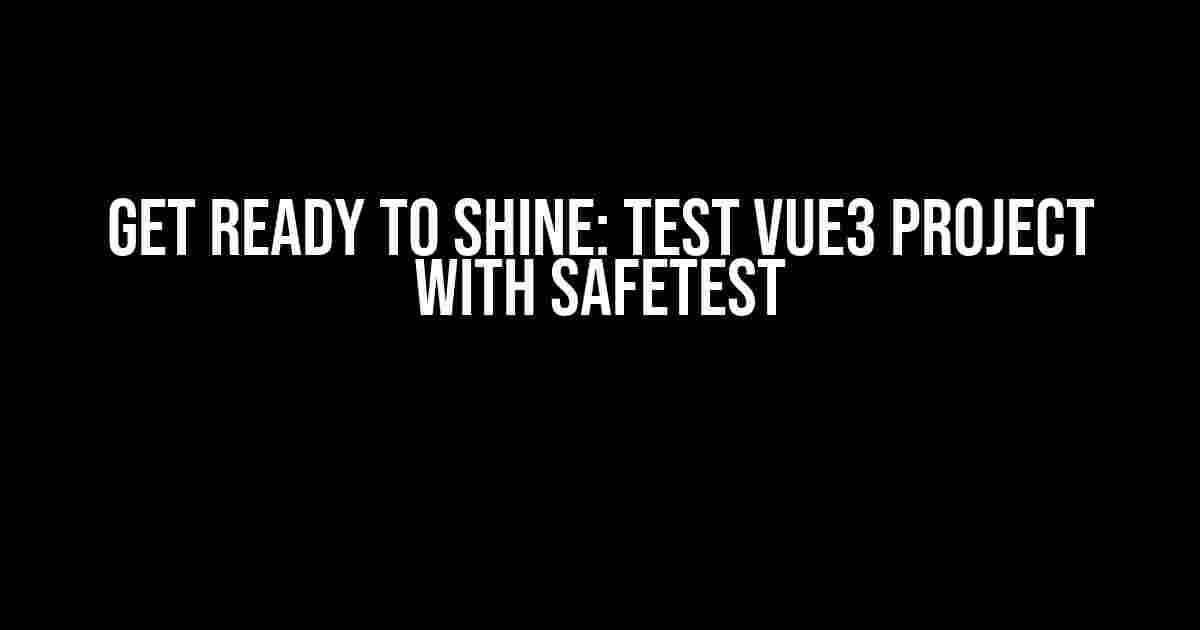Are you tired of tedious and time-consuming testing processes for your Vue3 projects? Look no further! Safetest is here to revolutionize the way you test your applications. In this comprehensive guide, we’ll walk you through the steps to set up and use Safetest with your Vue3 project, ensuring you’re up and running in no time.
What is Safetest?
Safetest is an innovative testing tool that allows you to write and run tests for your Vue3 applications quickly and efficiently. It provides a seamless integration with Vue3, making it a go-to choice for developers looking to streamline their testing process. With Safetest, you can focus on writing high-quality tests that cover all aspects of your application, ensuring it’s stable, reliable, and performs as expected.
Why Choose Safetest for Your Vue3 Project?
- Faster Testing**: Safetest allows you to write tests faster than traditional testing methods, saving you time and effort.
- Easier Debugging**: With Safetest, you can easily identify and debug issues in your application, reducing the time spent on troubleshooting.
- Better Code Coverage**: Safetest ensures that your tests cover all aspects of your application, giving you confidence in the quality of your code.
- Seamless Integration**: Safetest is designed to work seamlessly with Vue3, making it easy to set up and use.
Setting Up Safetest with Your Vue3 Project
To get started with Safetest, you’ll need to follow these simple steps:
npm install @safetest/coreoryarn add @safetest/coreto install Safetest.- Create a new file called `safetest.config.js` in the root of your project and add the following code:
module.exports = {
// The directory where your tests will be stored
testDir: './tests',
// The directory where your application code is stored
srcDir: './src',
};- Create a new file called `test.js` in the `tests` directory and add the following code:
import { safetest } from '@safetest/core';
safetest('My First Test', async () => {
// Your test code goes here
});Writing Your First Test with Safetest
Now that you have Safetest set up, let’s write our first test. In this example, we’ll test a simple Vue3 component that displays a greeting:
<template>
<p>Hello, {{ name }}!</p>
</template>
<script>
export default {
data() {
return {
name: 'John Doe',
};
},
};
</script>To test this component, we’ll create a new file called `Greeting.spec.js` in the `tests` directory:
import { safetest } from '@safetest/core';
import Greeting from '../src/components/Greeting.vue';
safetest('Greeting Component', async () => {
const wrapper = await safetest.mount(Greeting);
expect(wrapper.html()).toContain('Hello, John Doe!');
});Understanding the Test Code
In this example, we’re using the `safetest.mount()` function to render the `Greeting` component and get a reference to the rendered HTML. We then use the `expect()` function to assert that the HTML contains the expected text.
| Function | Description |
|---|---|
safetest.mount() |
Renders the component and returns a reference to the rendered HTML. |
expect() |
Asserts that the expected condition is true. |
Running Your Tests with Safetest
Now that we have our test written, let’s run it using Safetest:
npx safetestThis will execute our test and display the results:
› safetest
Greeting Component
✔ should render the correct greeting
Test Suites: 1 passed, 1 total
Tests: 1 passed, 1 total
Snapshots: 0 total
Time: 2.342s
Ran all test suites.Conclusion
In this comprehensive guide, we’ve covered the basics of setting up and using Safetest with your Vue3 project. We’ve also written and run our first test, ensuring that our application is working as expected. With Safetest, you can focus on writing high-quality tests that cover all aspects of your application, giving you confidence in the quality of your code.
Start testing your Vue3 project with Safetest today and experience the power of efficient and effective testing!
Happy testing!
Here are 5 Questions and Answers about “Test Vue3 project with safetest” in English:
Frequently Asked Questions
Get answers to your burning questions about testing Vue3 projects with safetest!
What is Safetest and how does it relate to Vue3 projects?
Safetest is a testing framework built on top of Jest, designed specifically for Vue3 projects. It provides a simple and efficient way to write unit tests, integration tests, and end-to-end tests for your Vue3 application. With Safetest, you can ensure your Vue3 project is stable, reliable, and performs well under various scenarios.
How do I set up Safetest in my Vue3 project?
Setting up Safetest in your Vue3 project is a breeze! Simply install Safetest using npm or yarn, then create a new file called `safetest.config.js` in the root of your project. In this file, you can configure Safetest to suit your project’s needs. Finally, update your `package.json` file to include a script for running Safetest.
What types of tests can I write with Safetest?
With Safetest, you can write three types of tests: unit tests, integration tests, and end-to-end tests. Unit tests focus on individual components or functions, integration tests examine how components interact with each other, and end-to-end tests simulate user interactions to ensure your app behaves as expected.
Can I use Safetest with existing testing frameworks like Jest or Mocha?
Yes, you can definitely use Safetest alongside existing testing frameworks like Jest or Mocha. Safetest is designed to be flexible and compatible with other testing tools, so you can seamlessly integrate it into your existing testing workflow.
Is Safetest compatible with Vue3’s Composition API?
Absolutely! Safetest is designed to work seamlessly with Vue3’s Composition API. You can write tests for your Composition API-based components with ease, ensuring your app’s logic is properly tested and validated.
